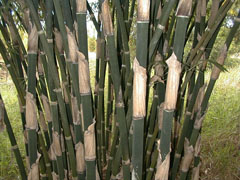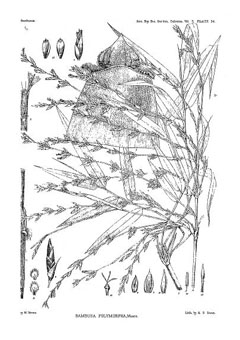 |
|
https://edibleplants.org/ |
 |
| https://edibleplants.org/ |
Translate this page:
Summary
Burmese Bamboo, Bambusa polymorpha, is a tropical plant that grows on lower slopes and in well drained valleys. It reaches up to 25 m tall and 15 cm across. The stems are erect but can curve towards the top part. It is grayish green in color, covered with whitish brown hair, and turn brownish green upon drying. Culms of this species are used as construction material. The plant can be grown from seeds or cuttings.
Other Names: Bar, Kyathaungwa, Narangi bas, Phai-hom.
Physical Characteristics

 Bambusa polymorpha is an evergreen Bamboo growing to 12 m (39ft) by 8 m (26ft) at a fast rate.
Bambusa polymorpha is an evergreen Bamboo growing to 12 m (39ft) by 8 m (26ft) at a fast rate.
See above for USDA hardiness. It is hardy to UK zone 9. The flowers are pollinated by Wind.
Suitable for: light (sandy), medium (loamy) and heavy (clay) soils and prefers well-drained soil. Suitable pH: mildly acid, neutral and basic (mildly alkaline) soils and can grow in very acid soils.
It can grow in semi-shade (light woodland) or no shade. It prefers moist soil. The plant can tolerates strong winds but not maritime exposure.
UK Hardiness Map
US Hardiness Map
Synonyms
Arundarbor polymorpha (Munro) Kuntze Bambusa cyanostachya Kurz ex Gamble
Plant Habitats
Edible Uses
Edible Parts: Shoots
Edible Uses:
Edible portion: Shoots. The young shoots are edible but are reputed to taste very bitter[ 310 ]. The plant yields excellent sweet shoots, but sometimes they are regarded as bitter[ 317]. The young shoots are harvested as they emerge from the soil.
References More on Edible Uses
Medicinal Uses
Plants For A Future can not take any responsibility for any adverse effects from the use of plants. Always seek advice from a professional before using a plant medicinally.
None known
References More on Medicinal Uses
The Bookshop: Edible Plant Books
Our Latest books on Perennial Plants For Food Forests and Permaculture Gardens in paperback or digital formats.

Edible Tropical Plants
Food Forest Plants for Hotter Conditions: 250+ Plants For Tropical Food Forests & Permaculture Gardens.
More

Edible Temperate Plants
Plants for Your Food Forest: 500 Plants for Temperate Food Forests & Permaculture Gardens.
More

More Books
PFAF have eight books available in paperback and digital formats. Browse the shop for more information.
Shop Now
Other Uses
Biomass Thatching Wood
Other uses rating: High (4/5). Agroforestry Uses: Commonly associated in the wild with teak (Tectona grandis), the plant is seen as an indicator of deep, rich, well-drained soils on which teak also develops well[ 310 , 418 ]. Other Uses Culms of Bambusa polymorpha are used for construction (walls, floors, roofs), matting, handicrafts, paper- and board-making[ 310 ]. The natural durability of Bambusa polymorpha is poor. Untreated, exposed culms are destroyed within 19 months by termites, fungi and borers. Traditionally, harvested culms are submerged for 10 - 20 days in running water and air dried before being used. Green culms lose about 40% of their weight when air dried[ 310 ].
Special Uses
Carbon Farming Food Forest
References More on Other Uses
Cultivation details
Industrial Crop: Biomass Management: Managed Multistem Minor Global Crop Other Systems: Multistrata Other Systems: Strip intercrop
A plant of the tropics. It grows best in areas where annual daytime temperatures are within the range 22 - 28c, but can tolerate 9 - 32c[ 418 ]. It prefers a mean annual rainfall in the range 1,200 - 2,500mm, but tolerates 700 - 4,500mm[ 418 ]. Prefers a position in light shade, tolerating full sun[ 418 ]. Grows best on a deep, fertile, well-drained, loam soils[ 310 , 418 ]. Prefers a pH in the range 5 - 6, tolerating 4.5 - 6.5[ 418 ]. Bamboos have an interesting method of growth. Each plant produces a number of new stems annually - these stems grow to their maximum height in their first year of growth, subsequent growth in the stem being limited to the production of new side branches and leaves. In the case of some mature tropical species the new stem could be as much as 30 metres tall, with daily increases in height of 30cm or more during their peak growth time. This makes them some of the fastest-growing species in the world[ K ]. Bamboos in general are usually monocarpic, living for many years before flowering, then flowering and seeding profusely for a period of 1 - 3 years before usually dying. The life cycle of this species is estimated at 60 years. It normally flowers gregariously for about 2 - 3 years, after which the clump dies[ 310 ]. Natural regeneration is through seed, which is produced abundantly. A seedling needs more than 10 years to develop into a mature clump[ 310 ]. In India, some 6-year-old clumps, developed from rhizome cuttings, contained on average 80 culms that were 11 metres tall and 17cm in diameter[ 310 ]. Harvesting of culms may start when clumps are more than 5 years old. Culms to be harvested should be older than 1.5 years; for construction purposes, 3 - 4-year-old culms are preferred. For a sustainable yield, at least 8 - 10 old culms should be left in the clump[ 310 ]. To protect natural bamboo forests, proper harvesting regulations should be established[ 310 ]. Production: A 1000 seeds weigh 38 g.
Carbon Farming
-
Industrial Crop: Biomass
Three broad categories: bamboos, resprouting woody plants, and giant grasses. uses include: protein, materials (paper, building materials, fibers, biochar etc.), chemicals (biobased chemicals), energy - biofuels
-
Management: Managed Multistem
Regularly removing some multiple stems. A non-A non-destructive management systems maintaining the soil organic carbon.
-
Minor Global Crop
These crops are already grown or traded around the world, but on a smaller scale than the global perennial staple and industrial crops, The annual value of a minor global crop is under $1 billion US. Examples include shea, carob, Brazil nuts and fibers such as ramie and sisal.
-
Other Systems: Multistrata
Multistrata agroforests feature multiple layers of trees often with herbaceous perennials, annual crops, and livestock.
-
Other Systems: Strip intercrop
Tree crops grown in rows with alternating annual crops.
References Carbon Farming Information and Carbon Sequestration Information
Temperature Converter
Type a value in the Celsius field to convert the value to Fahrenheit:
Fahrenheit:
The PFAF Bookshop
Plants For A Future have a number of books available in paperback and digital form. Book titles include Edible Plants, Edible Perennials, Edible Trees,Edible Shrubs, Woodland Gardening, and Temperate Food Forest Plants. Our new book is Food Forest Plants For Hotter Conditions (Tropical and Sub-Tropical).
Shop Now
Plant Propagation
Seed - surface sow in containers as soon as it is ripe, preferably at a temperature around 20?c. Do not allow the compost to dry out. Germination of around 40%[ 310 ] usually takes place fairly quickly so long as the seed is of good quality, though it can take 3 - 6 months. Prick out the seedlings into containers when they are large enough to handle and grow on in a lightly shaded place until large enough to plant out, at around 30 - 50cm tall[ 310 ]. Plants only flower at intervals of many years and so seed is rarely available. Division as new growth commences[ 220 ]. Take divisions with at least three canes in the clump, trying to cause as little root disturbance to the main plant as possible. Grow them on in light shade in pots of a high fertility sandy medium. Mist the foliage regularly until plants are established. Plant them out into their permanent positions when a good root system has developed, which can take a year or more[ 200 ]. Rhizome cuttings are preferably taken from 2-year-old culms; their survival rate is almost 100%. For larger plantations, rhizome cuttings are not practical because too many mother clumps have to be damaged[ 310 ]. Branch cuttings, planted under humid conditions, have been successful in Bangladesh (90% success rate); induction of roots and rhizomes on branches still on the living plant had a 80% success rate[ 310 ].
Other Names
If available other names are mentioned here
Burmese Bamboo, Bambusa polymorpha. Other Names: Bar, Kyathaungwa, Narangi bas, Phai-hom.
Native Range
TEMPERATE ASIA: Yunnan Sheng (south),China. TROPICAL ASIA: Bangladesh (east), India (northeast), Myanmar, Thailand (north),
Weed Potential
Right plant wrong place. We are currently updating this section.
Please note that a plant may be invasive in one area but may not in your area so it's worth checking.
None Known
Conservation Status
IUCN Red List of Threatened Plants Status : This taxon has not yet been assessed.

Growth: S = slow M = medium F = fast. Soil: L = light (sandy) M = medium H = heavy (clay). pH: A = acid N = neutral B = basic (alkaline). Shade: F = full shade S = semi-shade N = no shade. Moisture: D = dry M = Moist We = wet Wa = water.
Now available:
Food Forest Plants for Mediterranean Conditions
350+ Perennial Plants For Mediterranean and Drier Food Forests and Permaculture Gardens.
[Paperback and eBook]
This is the third in Plants For A Future's series of plant guides for food forests tailored to
specific climate zones. Following volumes on temperate and tropical ecosystems, this book focuses
on species suited to Mediterranean conditions—regions with hot, dry summers and cool, wet winters,
often facing the added challenge of climate change.
Read More
Expert comment
Author
Munro.
Botanical References
Links / References
For a list of references used on this page please go here
A special thanks to Ken Fern for some of the information used on this page.
Readers comment
| Add a comment |
|
If you have important information about this plant that may help other users please add a comment or link below. Only comments or links that are felt to be directly relevant to a plant will be included. If you think a comment/link or information contained on this page is inaccurate or misleading we would welcome your feedback at [email protected]. If you have questions about a plant please use the Forum on this website as we do not have the resources to answer questions ourselves.
* Please note: the comments by website users are not necessarily those held by PFAF and may give misleading or inaccurate information.
To leave a comment please Register or login here All comments need to be approved so will not appear immediately.
|
Subject : Bambusa polymorpha
|
|
|
|